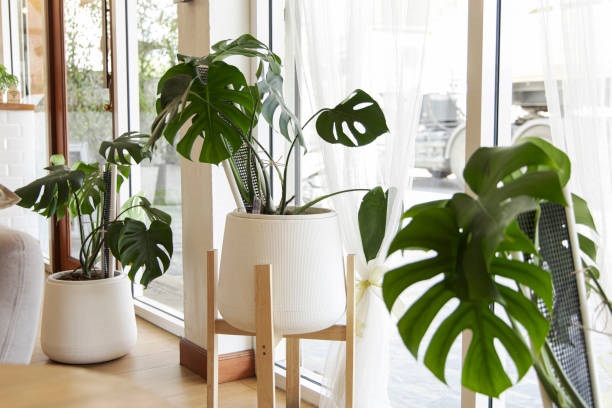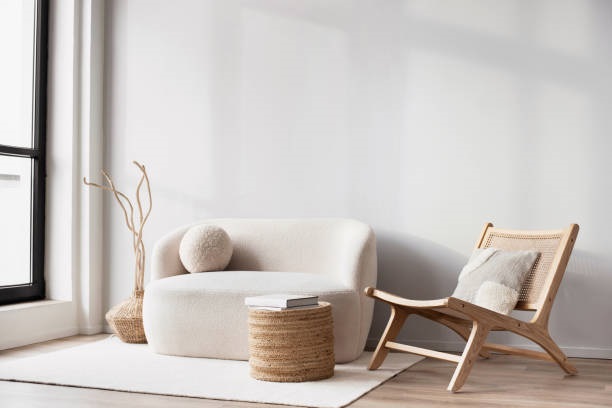
Select plants based on your home’s lighting conditions. Low-light areas suit snake plants and pothos, while sunny spots are perfect for succulents or fiddle leaf figs. Match plant size with room proportions for harmony.
Consider maintenance needs before choosing plants. Busy homeowners may prefer hardy species like ZZ plants, while plant enthusiasts can experiment with more delicate tropical varieties requiring regular watering, misting, and attention to humidity.
Evaluate the visual appeal of different foliage types. Large-leaf plants create bold statements, while trailing vines offer a softer, romantic touch. This selection influences the overall mood and design balance of your interior spaces.
Place large statement plants in living rooms or entryways to draw the eye. Tall plants like monstera or bird of paradise make a bold, welcoming impression and add visual height.
Position medium-sized plants on side tables or consoles. Their greenery softens sharp lines in furniture, making spaces feel more relaxed and inviting while maintaining a stylish and balanced visual composition.
In open spaces, group plants of varying heights for layered interest. This arrangement adds depth to the design, creating a dynamic and engaging visual landscape that enhances your overall room aesthetic.
Mix plants with books, artwork, and decorative objects on shelves. This combination creates a balanced, organic look that feels intentional rather than cluttered.
Choose trailing plants like ivy or string of pearls for upper shelves. Their cascading leaves soften edges and bring a natural flow to structured shelving layouts, making them visually appealing.
Add small potted plants to lower shelves for a grounded feel. Mixing textures like ceramic pots with greenery adds richness to your display, enhancing its charm and character.
Use hanging planters in kitchens, bathrooms, or corners to save floor space while adding greenery. This style works especially well in small apartments or minimalistic interiors.
Macramé plant hangers bring a bohemian charm to your décor. Choose neutral colors for a subtle effect or bold designs for a statement-making approach to plant display.
Install wall-mounted planters for a modern, space-saving solution. These allow you to create a living wall effect without taking up precious surface or floor space in your home.
The choice of pot influences the plant’s visual impact. Ceramic pots add elegance, woven baskets bring warmth, and metal planters suit modern, industrial interiors.
Coordinate pot colors with your overall interior palette. Neutral tones create harmony, while bright pots add playful accents that energize the room’s aesthetic.
Mix different pot sizes and shapes to create an eclectic, collected look. This adds depth and individuality to your indoor plant arrangements, making them more dynamic.
Repurpose vintage tins, teapots, or crates as plant containers for a unique look. This adds character and personality to your décor while supporting sustainable practices.
Use clear glass containers for plants with decorative roots, such as lucky bamboo. This adds visual interest and highlights the plant’s entire structure.
Experiment with upcycled containers to tell a story through your design. Old suitcases, baskets, or wooden boxes can be transformed into charming indoor plant displays.
Arrange plants in odd-numbered groups for a more natural appearance. Vary heights and textures to create depth and movement in your display.
Use plant stands to elevate smaller plants, creating a tiered effect. This enhances visibility and gives each plant a unique place within the composition.
Experiment with seasonal arrangements by swapping pots or adding new plants. This keeps your indoor garden feeling fresh and updated throughout the year.
Place small desk plants like succulents or peace lilies in your workspace to boost mood and productivity. These low-maintenance options bring life to your desk without demanding too much care.
Use vertical wall planters in offices with limited space. They provide greenery without cluttering work surfaces, contributing to a more relaxed and inspiring atmosphere.
Position plants near natural light sources to keep them healthy. Their presence also improves indoor air quality, enhancing comfort and wellness during work hours.
Bathrooms benefit from humidity-loving plants like ferns and orchids. These thrive in the moist environment while adding a spa-like touch.
Kitchens can feature herbs in small pots for both decorative and practical use. Fresh basil, rosemary, and mint add fragrance and flavor to your meals.
Place plants in areas that receive natural light but avoid harsh, direct sunlight that could scorch leaves. Hanging planters work well above sinks or near windows.
Pair plants with natural materials like wood, rattan, or stone to enhance their organic appeal. This combination creates a grounded, nature-inspired environment.
Mix soft textiles such as linen or wool with plant arrangements for a cozy feel. This layering makes rooms feel warmer and more inviting.
Incorporate reflective surfaces like mirrors or metallic décor near plants. This not only brightens the space but also visually multiplies the greenery.
Switch plants seasonally to reflect the time of year. Bright blooms for spring, lush greenery for summer, and warm-toned foliage for autumn keep interiors lively.
Use decorative elements like fairy lights in winter to highlight plants. This creates a magical, cozy effect during colder months.
Pair seasonal plants with matching pot colors or textures to create a cohesive look that feels intentional and timely.
Regularly dust leaves to keep plants looking fresh and healthy. Clean foliage also improves their ability to photosynthesize.
Water plants according to their needs, avoiding overwatering, which can cause root rot. Learn each plant’s care requirements for best results.
Rotate plants occasionally to ensure even growth. This keeps them symmetrical and well-balanced within your interior design.

This post has been published by the admin of our website, responsible for content management, quality checks, and providing valuable information to our users.

